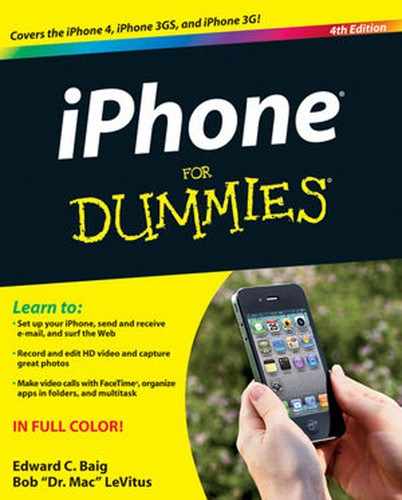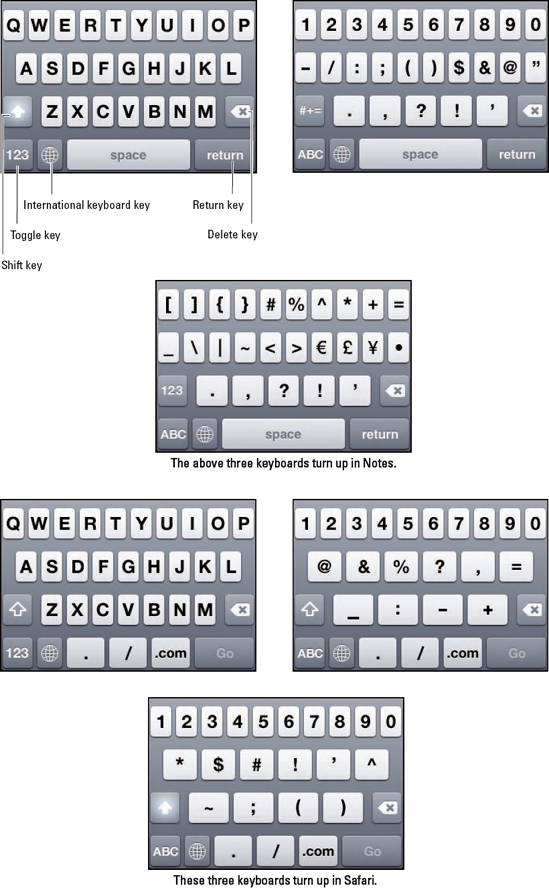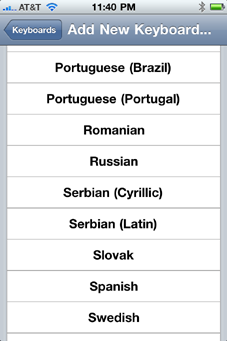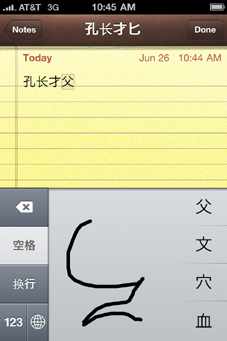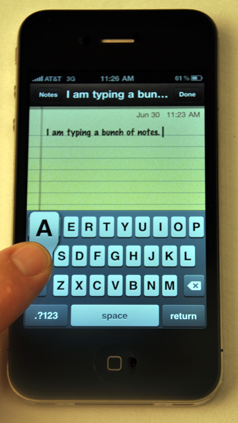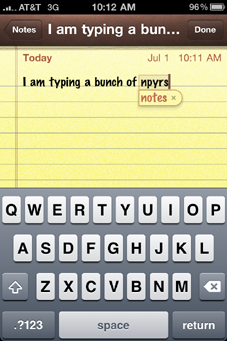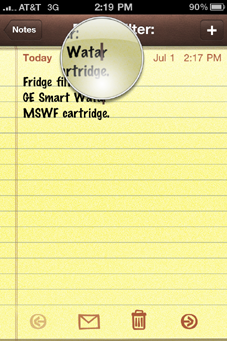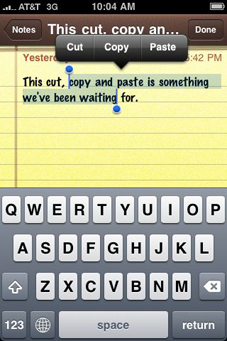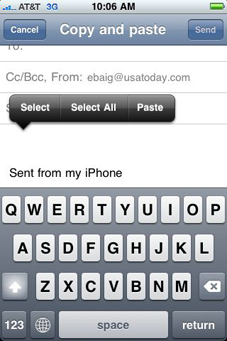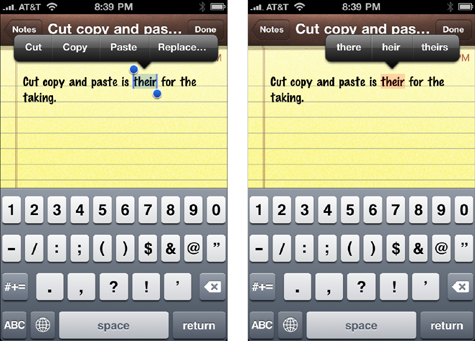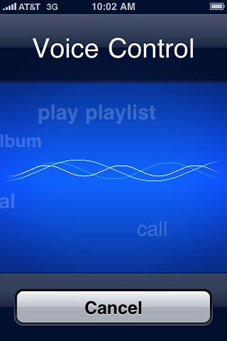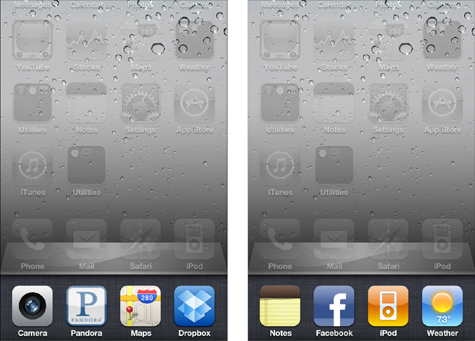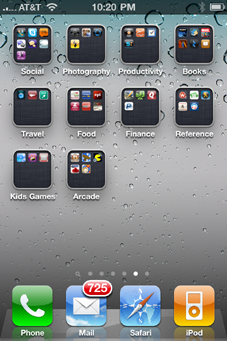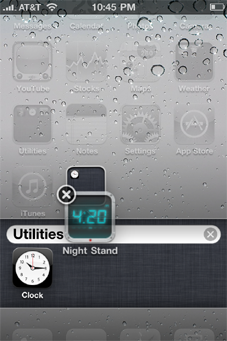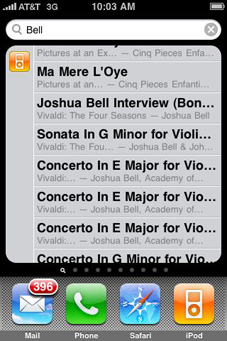In This Chapter
Activating your iPhone
Turning the device on and off
Locking your iPhone
Mastering multitouch
Cutting, copying, and pasting
Using voice dialing
Multitasking with your iPhone
Organizing folders
Spotlighting search
If you got caught up in the initial iPhone frenzy of 2007, you may have plotted for months about how to land one. After all, the iPhone quickly emerged as the ultimate fashion phone. And the chic device hosted a bevy of cool features.
To snag the very first version, you may have saved your pennies or said, "The budget be damned." Owning the hippest and most-hyped handset on the planet came at a premium cost compared with rival devices.

Today's iPhone is no less hip or cool, though you now get more bang for your buck. Apple has lowered the price — a lot. As of this writing, the cheapest iPhone for new U.S. customers starts at $99 with a two-year AT&T contract — $500 below its stratospheric launch price. The least expensive version is the iPhone 3GS model with 8GB of RAM. If you're not bargain hunting, you'll want the newer iPhone 4, $199 with 16GB of RAM or $299 for 32GB. Those are subsidized prices that in the United States require a mandatory two-year contract with AT&T. For existing iPhone customers, the upgrade price for a new iPhone 4 model depends on how far you're into your previous contract with AT&T, how prompt you are at paying your bill, and other factors.
Purchasers of the iPhone 4 experience a new and better activation experience than those 2007 buyers who got in on the bleeding edge. Back then, no salesperson was going to guide you through the process, whether you picked up your newly prized possession in an Apple retail store, an AT&T retail store, or on the Web. Instead, you handled activation solo, in the comfort of your home.
Unless you were among those people who encountered activation hiccups in the days soon after the phone was released in June 2007, the process of getting up to speed with the iPhone was (for the most part) dirt simple and fun — as it is with most products with an Apple pedigree. Still, there were some well-publicized issues in those days, so Apple eventually changed the protocol.
You're now supposed to activate the iPhone in the Apple, AT&T Wireless, Best Buy, RadioShack, or Wal-Mart store where you bought the thing, just as you do with other cell phones. However, if you buy your iPhone from Apple's online store, they'll ship it to you and you activate it through iTunes, just like the old days. You also choose your desired monthly bucket of voice minutes and SMS (Short Message Service) or text messages as well as your allotment of wireless data minutes right in the store.
As of this writing, AT&T offers a $15 a month DataPlus plan, with 200MB of data, roughly enough to send or receive about 1,000 e-mails without attachments and about 150 messages with attachments. You can also view about 400 Web pages, post about 50 photos on social media sites, and watch about 20 minutes of streaming video. (At least that's what AT&T estimates; we didn't count.)
If you exceed 200MB of usage, you'll receive an additional 200MB within the cycle for $15.
The DataPro plan costs $25 per month and gives you 2GB of data, enough to send or receive approximately 10,000 e-mails without attachments and 1,500 e-mails with attachments, view 4,000 Web pages, post 500 photos to social media sites, and watch 200 minutes of streaming video. If you exceed 2GB, you can get another 1GB for $10.
Tip
AT&T reports that 98 percent of smartphone customers use less than 2GB. So think long and hard about your anticipated usage before choosing a plan. It's also worth noting that these charges apply only to accessing AT&T's 3G and Edge networks and don't count when you connect via Wi-Fi in your home, office, or elsewhere.
Tip
DataPro plan customers have the option to add tethering for an additional $20 a month. Tethering is the capability to use the iPhone as a broadband modem for other devices you might carry, such as laptops and netbooks, but alas not Apple's own iPad tablet.
If you're already an AT&T subscriber, the salesperson will give you the option of keeping your current phone number.
Note
It's not surprising why Apple and AT&T want you in their stores: After they get you in the door, they have the opportunity to sell you other stuff. And they can help crack down on techies who want to unlock, or "jailbreak," the iPhone to defect to a rival carrier.
The same two prerequisites for enjoying the iPhone are in place as with the original release and all other iPhones — at least for U.S. customers. First, there's the aforementioned business of becoming an AT&T (formerly Cingular) subscriber, unless you're already in the fold. You'll have to ink that new two-year term. If you're in the middle of a contract with a rival carrier, read the sidebar titled "The Great Escape: Bailing out of your wireless contract."
Second, make sure you download the latest version of iTunes software onto your PC or Mac. Apple doesn't supply the software in the box, so head to www.apple.com/itunes if you need to fetch a copy, or launch your current version of iTunes and then choose iTunes
For the uninitiated, iTunes is the nifty Apple jukebox software that iPod owners and many other people use to manage music, videos, and more. iTunes is at the core of the iPhone as well because an iPod is built into the iPhone. You'll employ iTunes to synchronize a bunch of stuff on your computer and iPhone, including apps, photos, podcasts, videos, ringtones, and (of course) music.
We get into all that syncing business in Chapter 3.
Apple has taken the time to partially charge your iPhone, so you'll get some measure of instant gratification. After taking it out of the box, press and hold the sleep/wake button on the top-right edge. (Refer to Chapter 1 for the location of all buttons.) If the phone has been activated, the famous Apple logo appears on your screen, followed a few seconds later by a stunning gray image covered by raindrops. You can find out how to redecorate this wallpaper in Chapter 13. If the phone is shipped to you from the Apple Store, you get a Connect to iTunes screen so that the device can connect with AT&T's servers and perform the activation.
To turn the device completely off, press and hold the sleep/wake button again until a red arrow appears at the top of the screen. Then drag the arrow to the right with your finger. Tap Cancel if you change your mind.
Carrying a naked cell phone in your pocket is asking for trouble. Unless the phone has some locking mechanism, you may inadvertently dial a phone number. Try explaining to your boss why he or she got a call from you at 4 a.m. Fortunately, Apple makes it a cinch to lock the iPhone so this scenario won't happen to you.
In fact, you don't need to do anything to lock the iPhone; it happens automatically, as long as you don't touch the screen for one minute. (You can change this duration in iPhone Settings, a topic in Chapter 13.)
Can't wait? To lock the iPhone immediately, press the sleep/wake button. To unlock it, press the sleep/wake button again. Or press the Home button on the front of the screen. Either way, the on-screen slider appears, but you can't do anything until you drag the slider to the right with your finger and then, in some cases, also enter a passcode, another topic reserved for Chapter 13.
By now, you're picking up on the idea that your fingers play an instrumental role in controlling your iPhone. We talk more about the responsibility your digits have later in this chapter.
Until the iPhone came along, virtually every cell phone known to mankind had a physical (typically plastic) dialing keypad, if not also a more complete QWERTY-style keyboard, to bang out e-mails and text messages. The iPhone dispenses with both. Apple is once again living up to an old company advertising slogan to "Think Different."
Indeed, the iPhone removes the usual physical buttons in favor of a multitouch display. This display is the heart of many things you do on the iPhone, and the controls change depending on the task at hand.
Unlike other phones with touchscreens, don't bother looking for a stylus. You are meant, instead — at the risk of lifting another ancient ad slogan — to "let your fingers do the walking."
It's important to note that you have at your disposal several keyboard layouts in English, all variations on the alphabetical keyboard, the numeric and punctuation keyboard, and the more punctuation and symbols keyboard. Six keyboards are shown in Figure 2-1. The layout you see depends on the app you are working in. For instance, the keyboards in Safari differ from the keyboards in Notes.
Tip
What's more, if you rotate the iPhone to its side, you'll get wider variations of the respective keyboards. A single example of a wide keyboard in the Notes app is shown in Figure 2-2.
The iPhone keyboard contains five keys that don't actually type a character (refer to Figure 2-1). These special-use keys follow:
Shift key: Switches between uppercase and lowercase letters if you're using the alphabetical keyboard. If you're using keyboards that show only numbers and symbols, the traditional shift key is replaced by a key labeled #+= or 123. Pressing that key toggles between keyboards that have just symbols and numbers.
Tip
To turn on Caps Lock mode and type in all caps, you first need to enable Caps Lock. You do that by tapping the Settings icon, then tapping General, and then tapping Keyboard. Tap the Enable Caps Lock item to turn it on. After the Caps Lock setting is enabled (it's disabled by default), you double-tap the shift key to turn on Caps Lock. (The shift key turns blue when Caps Lock is on.) Tap the shift key again to turn off Caps Lock. To disable Caps Lock completely, just reverse the process by turning off the Enable Caps Lock setting (tap Settings, General, Keyboard).
Toggle key: Switches between the different keyboard layouts.
International keyboard key: Shows up only if you've turned on an international keyboard, as explained in the sidebar titled "A keyboard for all borders," later in this chapter.
Delete key: Erases the character immediately to the left of the cursor.
Tip
If you hold down the delete key for a few seconds, it begins erasing entire words rather than individual characters.
Return key: Moves the cursor to the beginning of the next line.
Before you consider how to actually use the keyboard, we'd like to share a bit of the philosophy behind its so-called intelligence. Knowing what makes this keyboard smart will help you make it even smarter when you use it. The iPhone keyboard
Suggests corrections as you type. It then offers you the suggested word just below the word you typed. When you decline a suggestion and the word you typed is not in the iPhone dictionary, the iPhone adds that word to its dictionary and offers it as a suggestion if you mistype a similar word in the future.
Tip
Remember to decline suggestions (by tapping the characters you typed as opposed to the suggested words that appear below what you've typed), because doing so helps your intelligent keyboard become even smarter.
Reduces the number of mistakes you make as you type by intelligently and dynamically resizing the touch zones for certain keys. You can't see it, but the iPhone increases the zones for keys it predicts might come next and decreases the zones for keys that are unlikely or impossible to come next.
The Home screen, which we discuss in Chapter 1, more than likely won't end up being the only screenful of icons on your phone. After you start adding apps from the iTunes App Store (see Chapter 14), you'll likely have multiple screens.
Initially, you see three tiny dots above the Phone, Mail, Safari, and iPod icons. Each dot denotes an additional screen, containing up to 16 additional icons for apps or folders of apps. The leftmost dot, which is dimmed (and on close inspection shaped like a tiny magnifying glass), denotes the Search screen, which you access by flicking from left to right across the middle of the screen or by tapping directly on the dot. The second dot, which is all-white, represents the Home screen, or the screen you're currently viewing. The next dot to the right is the first additional screen in which you can park icons. You get to it by flicking right to left or tapping on the dot. You can have 11 screens in all; as you add screens, you add dots.
Tip
You must be precise when tapping a dot, or you'll open one of the app or folder icons instead of switching screens.
The four icons in the last row — Phone, Mail, Safari, and iPod — are in a part of the screen known as the dock. When you switch from screen to screen as just described, these icons remain on the screen.
You can easily move icons within a screen or from screen to screen. Simply press and hold any icon until all the icons on the screen begin to jiggle. Then drag the icon you want to park elsewhere to its new location. The other icons on the screen kindly step aside to make room. To move an icon to an entirely new screen, drag it to the right or left edge of the screen. When you're satisfied with the new layout, press the Home button to stop the jiggling.
Press the Home button to jump back to the first screenful of icons or the Home screen. Pressing a second time brings you to a handy Spotlight search feature, which we address at the end of this chapter, in the "Search" section.
Warning
If you press two times in rapid succession, you won't jump to the first Home screen or Spotlight Search screen. Instead, the multitasking tray (described in the "Multitasking" section, later in this chapter) appears. So remember to pause briefly between presses if you want to jump to the Home or Spotlight Search screens and press twice in rapid succession to invoke multitasking.
Apple's multitouch interface just might be considered a stroke of genius. And it just might as equally drive you nuts, at least initially.
If you're patient and trusting, you'll get the hang of finger-typing in a week or so. (We've become quite good at it by now.) You have to use the virtual keyboard that appears when you tap a text field to enter notes, compose text messages, type the names of new contacts, and so forth.
Tip
Apple's own recommendation — with which we concur — is to start typing with just your index finger before graduating to two thumbs.
As we've noted, Apple has built a lot of intelligence into its virtual keyboard, so it can correct typing mistakes on the fly and take a stab at predicting what you're about to type next. The keyboard isn't exactly Nostradamus, but it does a pretty good job in coming up with the words you have in mind.
As you press your finger against a letter or number on the screen, the individual key you press gets bigger and practically jumps off the screen, as shown in Figure 2-3. That way, you know that you struck the correct letter or number.
Tip
Sending a message to an overseas pal? Keep your finger pressed against a letter, and a row of keys showing variations on the character for foreign alphabets pops up, as shown in Figure 2-4. Then you can add the appropriate accent mark. Just slide your finger until you reach the key with the relevant accent mark, and press.
Meanwhile, if you press and hold the .com key on a Safari keyboard, it offers you the choice of .com, .net, .edu, .us, or .org. Pretty slick stuff.
Tip
If you enabled any international keyboards, you'll see more choices when you hold down the .com key. For example, if you enabled a French keyboard, pressing and holding .com will also give you options for .eu and .fr.
Alas, typing mistakes are common at first. Say that you meant to type a sentence in the Notes app that reads, "I am typing a bunch of notes." But because of the way your fingers struck the virtual keys, you actually entered "I am typing a bunch of npyrs." Fortunately, Apple knows that the o you meant to press is next to the p that showed up on the keyboard, just as t and y and the e and the r are side-by-side. So the software determines that notes was indeed the word you had in mind and places it in red under the suspect word, as shown in Figure 2-5. To accept the suggested word, merely tap the Space key. And if for some reason you actually did mean to type npyrs instead, tap the suggested word (notes in this example) to decline it.
Tip
Because Apple knows what you're up to, the virtual keyboard is customized for the task at hand. If you're entering a Web address, the keyboard inside the Safari Web browser (Chapter 10) includes dedicated period, forward slash, and (the aforementioned) .com keys but no Space key.
If you're using the Notes app (Chapter 5), the keyboard does have a Space key. And if you're composing an e-mail message, a dedicated @ key pops up on the keyboard.
Warning
When you're typing notes or sending e-mail and want to type a number, symbol, or punctuation mark, tap the 123 key to bring up an alternative virtual keyboard. Tap the ABC key to return to the first keyboard. It's not hard to get used to, but some may find this extra step irritating.
See Chapter 18 for a slick trick (the slide) that avoids the extra step involved in moving between the 123 and ABC keys.
As mentioned, you can rotate the iPhone so that its keyboard changes to a wider landscape mode in certain apps, most recently, Mail, Messages, and Notes. The feature was already present in Safari. The keys are slightly larger in landscape mode, a potential boon to those who do a lot of typing or have largish fingers.
It's a good idea to type with abandon and not get hung up over mistyped characters. The self-correcting keyboard will fix many errors. That said, plenty of typos will likely turn up, especially in the beginning, and you'll have to make corrections manually.
Tip
A neat trick for doing so is to hold your finger against the screen to bring up the magnifying glass shown in Figure 2-6. Use it to position the pointer to the spot where you need to make the correction.
Being able to copy and paste text (or images) from one place on a computer to another has seemingly been a divine right since Moses, but getting to this Promised Land on the iPhone took awhile. Apple added Copy and Paste (and Cut) as part of OS 3.0. In its own inimitable way, Apple brought pizzazz to this long-requested feature. And with iOS 4, Apple has provided another helpful remedy for correcting errors. It's a new Replace pop-up option that appears when you double-tap a word.
On the iPhone, you might want to copy text or images from the Web, and paste them into an e-mail, text, a message, or a note. Or you might want to copy a bunch of pictures or a video into an e-mail.
Here's how to exploit the feature. Say you're in the Notes app, jotting down ideas that you want to copy into an e-mail message. Double-tap a word to select it, and then drag the blue grab points or handles to select a larger block of text (see Figure 2-7). (You can use the handles to contract selected text too.) After you've selected the text, tap Copy. (If you want to delete the text block, tap Cut instead.)
Now open the Mail program (Chapter 11) and start composing a message. When you decide where to insert the text you just copied, tap the cursor. Up pop commands to Select, Select All, and Paste, as shown in Figure 2-8. Tap Paste to paste the text into the message.
Here's the pizzazz part. If you make a mistake while you are cutting, pasting, replacing, or typing, shake the iPhone. It undoes the last edit.
Say you notice a typo in what you had previously entered. In Figure 2-9, for example, we inadvertently typed their instead of there. By tapping Replace, you can easily make a fix. Upon doing so, the iPhone serves up a few suggested replacement words. If the word you have in mind as a substitute is, um, there, tap it and the iPhone automatically makes the switch.
Several cell phones of recent vintage let you dial a name or number by voice. Bark out "Call Mom" or "Dial 212-555-1212" and such handsets oblige. Although some third-party apps added voice dialing to the iPhone, Apple didn't get around to it until OS 3.0, as part of the feature known as Voice Control.
As you see in Chapter 7, Apple took voice controls a step beyond dialing by number or finding people in your address book. You can also issue voice commands to control music in the iPod.
You have two ways to summon the Voice Control feature:
Press and hold the Home button until the Voice Control screen shown in Figure 2-10 appears. It has wavy lines that move as you speak. Scrolling in the background are some of the commands you can say out loud ("Play Artist," "Previous Track," and so on). Don't blurt out anything until you hear a quick double-beep. The iPhone will repeat the command it thinks it heard.
Press and hold the center button on the wired headset. Once again, wait for an audible cue and then tell the iPhone what you have in mind.
Voice Control works quite nicely with the wired headset included with your iPhone. It works also with some Bluetooth headsets and car kits. If you use a wireless headset that's not supported, you'll have to hold the phone up to your lips if you want it to respond to voice commands.
Warning
You definitely want to wait for voice confirmation after you've spoken. In our experience, Voice Control isn't perfect, especially in a noisy environment. So if you're dialing a name or number, make sure the iPhone is indeed calling the person you had in mind. There's no telling what kind of trouble you might get into otherwise.
iOS 4 adds a bevy of important features, of which the long-overdue multitasking feature is arguably the most significant. Multitasking simply lets you run numerous apps in the background simultaneously or easily switch from one app to another. For example, music from a third-party app such as Slacker can play in the background while you surf the Web, peek at pictures, or check e-mail. Before multitasking hit the iPhone, Slacker would shut itself down the moment you started performing tasks in another app. (Previously, Apple did let you multitask by, for example, playing audio in the background with its iTunes app. But multitasking was limited to Apple's own apps, not those produced by outside developers.)
But that's not all. If you use an Internet voice-calling app such as Skype, you'll be able to receive notification of an incoming call even if you haven't launched the Skype app. The multitasking feature also lets a navigation app employing GPS update your position while you're listening to an Internet radio app such as Pandora. From time to time, the navigation app will pipe in with turn-by-turn directions, lowering the volume of the music so you can hear the instructions.
And if you're uploading images to a photo Web site and the process is taking longer than you'd like, you can switch to another app, confident that the images will continue to upload behind the scenes. We've also been able to leave voice notes in the Evernote app while checking out a Web page.
Multitasking couldn't be easier. Double-press the Home button, and a tray appears at the bottom of the screen, as shown in Figure 2-11. The tray holds icons for the most recently used apps. Scroll to the right to see more apps (see Figure 2-11, right). Tap the app you want to switch to: The app remembers where you left off.
Apple insists that multitasking will not drain the iPhone battery or exhaust system resources. The iPhone conserves power and resources by putting apps in a state of suspended animation. But as we just mentioned, you can wake them up instantly and return to what you were doing.
Tip
To remove an app from the tray holding icons of the most recently used apps — and thus remove the app from those in the multitasking rotation — press and hold your finger against any app until they all start to wiggle. Then tap the red circle with the white line that appears inside the app you want to remove. Poof, it's gone.
Warning
Multitasking works only on the iPhone 3GS and iPhone 4 models, and presumably any future models. Older iPhones don't have the resources to handle the feature.
Note that multitasking on the iPhone doesn't work quite the same way as multitasking on a PC or a Mac. You can't display more than one window on the screen at a time — given the size of the iPhone screen, you'd have trouble viewing multiple windows anyway.
Moreover, there's some philosophical debate whether this feature is multi-tasking, or fast task switching, or some combination. Rather than getting bogged down in the semantics, we're just glad that multitasking, or whatever it is, has finally arrived.
Finding the single app you want to use among apps spread out over 11 screens is a daunting task. But Apple felt your pain, and with iOS 4, the company introduced a handy organization tool called Folders. The Folders feature enables you to create folder icons, each holding up to a dozen apps. As Figure 2-12 shows, you might create folders for Social apps, Photography, Travel, and any number of other categories.
To create a folder, press your finger against an icon until all the icons on the screen jiggle. Decide which apps you want to move to a folder, and drag the icon for the first app on top of the second app. The two apps now share living quarters inside a newly created folder, as shown in Figure 2-13. Apple names the folder according to the category of apps inside the folder, but you can easily change the folder name by tapping the X in the bar where the folder name appears and substituting a new name.
To launch an app that's inside a folder, tap that folder's icon and then tap the icon for the app that you want to open.
You can drag apps into and out of any folder as long as there's room for them — remember that you can have no more than 12 apps in a folder. But your iPhone can have as many as 180 folders, with a total of 2,160 apps.
If you drag all the apps outside the folder, it automatically disappears.
Using the Safari browser (see Chapter 10), you can search the Web via Google, Yahoo!, or Microsoft Bing. But you can also search for people and programs across your iPhone or within specific apps. We show you how to search within apps in the various chapters dedicated to Mail, Contacts, Calendar, Notes, and iPod.
Searching across the iPhone, meanwhile, is based on the Spotlight feature familiar to Mac owners. To access Spotlight, flick to the left of the main Home screen (or as mentioned earlier in this chapter, press the Home button from the Home screen).
In the bar at the top of the screen that slides into view, enter your search query using the virtual keyboard. The iPhone starts spitting out results the moment you type a single character, and the list narrows as you type additional characters.
The results are pretty darn thorough. Say you entered Bell as your search term, as shown in Figure 2-14. Contacts whose names have Bell in them will show up, along with folks who work for companies named Bell. If your iTunes library has the song "One Last Bell to Answer" or music performed by violinist Joshua Bell, those will show up, too. Same goes for a third-party iPhone app called The Bell. Tap any listing to jump to the contact, ditty, or app you're searching for.
Tip
If you don't find what you're looking for, you can take your search into cyberspace. At the very bottom of the search results that popped up are two additional options, Search Web and Search Wikipedia. Tap the latter to fire up Safari and visit the vast online Wikipedia encyclopedia. The search term you entered (Bell) is already selected. If you tap Search Web instead, Safari brings you to a Google search page, prepopulated with the search term you selected.
You have some control over the type of search that Spotlight conducts. From the Home page, tap Settings, General, Spotlight Search. Make sure there's a check mark next to each app on the iPhone that you'd like searched automatically. By default, all the options — Contacts, Applications, Music, Podcasts, Video, Audiobooks, Notes, Mail, Calendar, and Messages — are selected. Tap to remove the check mark from any app that you don't want automatically included in your search.
There — you've survived basic training. Now the real fun is about to begin.
